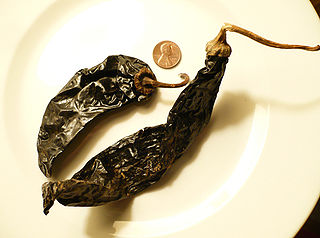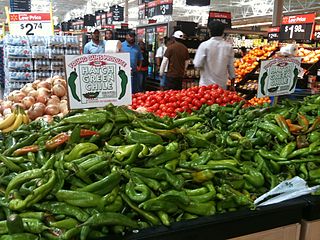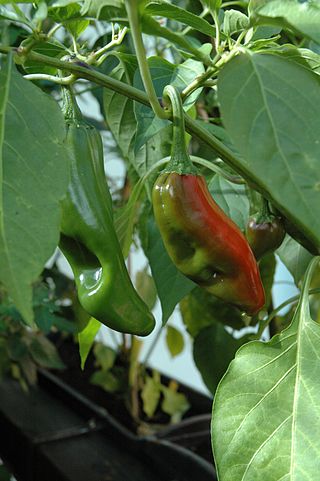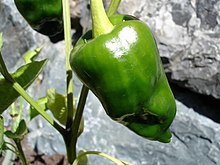
The Scoville scale is a measurement of pungency of chili peppers and other substances, recorded in Scoville heat units (SHU). It is based on the concentration of capsaicinoids, among which capsaicin is the predominant component.

Chili peppers, also spelled chile or chilli, are varieties of berry-fruit plants from the genus Capsicum, which are members of the nightshade family Solanaceae, cultivated for their pungency. Chili peppers are widely used in many cuisines as a spice to add "heat" to dishes. Capsaicin and the related capsaicinoids give chili peppers their intensity when ingested or applied topically. Chili peppers exhibit a range of heat and flavors. This diversity is the reason behind the availability of different types of chili powder, each offering its own taste and heat level.

A chipotle, or chilpotle, is a smoke-dried ripe jalapeño chili pepper used for seasoning. It is a chili used primarily in Mexican and Mexican-inspired cuisines, such as Tex-Mex and Southwestern United States dishes. It comes in different forms, such as chipotles en adobo.

Chili powder is the dried, pulverized fruit of one or more varieties of chili pepper, sometimes with the addition of other spices. It is used as a spice to add pungency (piquancy) and flavor to culinary dishes. In American English, the spelling is usually "chili"; in British English, "chilli" is used consistently.

Hot sauce is a type of condiment, seasoning, or salsa made from chili peppers and other ingredients. Many commercial varieties of mass-produced hot sauce exist.

The chile relleno is a dish in Mexican cuisine that originated in the city of Puebla. In 1858, it was described as a "green chile pepper stuffed with minced meat and coated with eggs".

The pasilla chile or chile negro is the dried form of the chilaca chili pepper, a long and narrow member of the species Capsicum annuum. Named for its dark, wrinkled skin, it is a mild to hot, rich-flavored chile. As dried, it is generally 6 to 8 inches long and 1 to 1+1⁄2 inches in diameter.
Chile is a country in South America.

A guajillo chili or guajillo chile or chile guaco or mirasol chile is a landrace variety of the species Capsicum annuum with a mirasol chile fruit type. Mirasol is used to refer to the fresh pepper, and the term guajillo is used for the dry form, which is the second-most common dried chili in Mexican cuisine. The Mexican state of Zacatecas is one of the main producers of guajillo chilies. There are two main varieties that are distinguished by their size and heat factors. The guajillo puya is the smaller and hotter of the two. In contrast, the longer and wider guajillo has a more pronounced, richer flavor and is somewhat less spicy. With a rating of 2,500 to 5,000 on the Scoville scale, its heat is considered mild to medium.

The Fresno chile or Fresno chili pepper is a medium-sized cultivar of Capsicum annuum. It should not be confused with the Fresno Bell pepper. It is often confused with the jalapeño pepper but has thinner walls, often has milder heat, and takes less time to mature. It is, however, a Fresno County chile, which is genetically distinct from the jalapeño and it grows point up, rather than point down as with the jalapeño. The fruit starts out bright green changing to orange and red as fully matured. A mature Fresno pepper will be conical in shape, 50 mm (2 in) long, and about 25 mm (1 in) in diameter at the stem. The plants do well in warm to hot temperatures and dry climates with long sunny summer days and cool nights. They are very cold-sensitive and disease resistant, reaching a height of 60–75 cm (24–30 in).

Mole, meaning 'sauce', is a traditional sauce and marinade originally used in Mexican cuisine. In contemporary Mexico the term is used for a number of sauces, some quite dissimilar, including mole amarillo or amarillito, mole chichilo, mole colorado or coloradito, mole manchamantel or manchamanteles, mole negro, mole rojo, mole verde, mole poblano, mole almendrado, mole michoacano, mole prieto, mole ranchero, mole tamaulipeco, mole xiqueno, pipián, mole rosa, mole blanco, mole estofado, tezmole, clemole, mole de olla, chimole, guacamole and huaxmole.

Oaxacan cuisine is a regional cuisine of Mexico, centered on the city of Oaxaca, the capital of the eponymous state located in southern Mexico. Oaxaca is one of the country's major gastronomic, historical, and gastro-historical centers whose cuisine is known internationally. Like the rest of Mexican cuisine, Oaxacan food is based on staples such as corn, beans, and chile peppers, but there is a great variety of other ingredients and food preparations due to the influence of the state's varied geography and indigenous cultures. Corn and many beans were first cultivated in Oaxaca. Well-known features of the cuisine include ingredients such as chocolate, Oaxaca cheese, mezcal, and grasshoppers (chapulines), with dishes such as tlayudas, Oaxacan-style tamales, and seven notable varieties of mole sauce. The cuisine has been praised and promoted by food experts such as Diana Kennedy and Rick Bayless and is part of the state's appeal for tourists.

New Mexico chile or New Mexican chile is a cultivar group of the chile pepper from the US state of New Mexico, first grown by Pueblo and Hispano communities throughout Santa Fe de Nuevo México. These landrace chile plants were used to develop the modern New Mexico chile peppers by horticulturist Fabián García and his students, including Roy Nakayama, at what is now New Mexico State University in 1894.

Bird's eye chili or Thai chili is a chili pepper variety from the species Capsicum annuum that is native to Mexico. Cultivated across Southeast Asia, it is used extensively in many Asian cuisines. It may be mistaken for a similar-looking chili derived from the species Capsicum frutescens, the cultivar siling labuyo. Capsicum frutescens fruits are generally smaller and characteristically point upwards. In the Marianas and Guam these are often called boonie peppers or Doni Sali, which can be term for regional wild varieties. The variation between different varieties can be significant for regional dishes or visuals, such as the Thai ornamental varieties.

Capsicum is a genus of flowering plants in the nightshade family Solanaceae, native to the Americas, cultivated worldwide for their edible fruit, which are generally known as "peppers" or "capsicum". Chili peppers grow on five species of Capsicum. Sweet or bell peppers and some chili peppers are Capsicum annuum, making it the most cultivated species in the genus.

The habanero is a pungent cultivar of Capsicum chinense chili pepper. Unripe habaneros are green, and they color as they mature. The most common color variants are orange and red, but the fruit may also be white, brown, yellow, green, or purple. Typically, a ripe habanero is 2–6 centimetres long. Habanero chilis are very hot, rated 100,000–350,000 on the Scoville scale. The habanero heat, flavor, and floral aroma make it a common ingredient in hot sauces and other spicy foods.
The Sandia pepper or Sandia chile pepper is a New Mexico chile pepper cultivar of the species Capsicum annuum with a scoville rating which ranges from mild to hot. This cultivar is extensively grown in New Mexico where it was developed and is popular in New Mexican cuisine. Sandia peppers picked while still green are typically roasted to produce green chile. When ripened, this variety can be dried and ground to make chile powder. Sandia peppers grown and consumed in New Mexico are most commonly used to make red or green posole, green chile stew, and carne adovada.

The Big Jim pepper is a New Mexico chile pepper cultivar of the species Capsicum annuum with a Scoville rating of mild. This cultivar is extensively grown in New Mexico where it was developed and is popular in New Mexican cuisine. Big Jim peppers are both sweet and mild and are normally picked while still green. The fruits are large and thick walled, often exceeding over a foot in length, and they are almost exclusively used to produce roasted green chile in New Mexican cuisine.
Ancho Reyes is a brand of chile liqueur produced in Puebla City, Mexico, based on a 1927 recipe from the same city. The liqueur is made from and named after Puebla's renowned ancho chiles, a dried form of ripe poblano peppers.


















